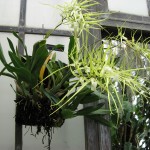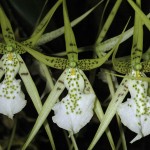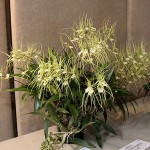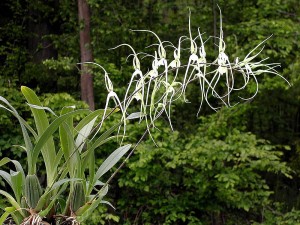Family: Orchidaceae
Synonymous: Brassia verrucosa subsp. gireoudiana
Brassia aristata
Brassia brachiata
Brassia coryandra
Brassia cowanii
Brassia longiloba
Brassia odontoglossoides
Oncidium brachiatum
Oncidium verrucosum
Distribution and habitat: Brassia verrucosa is an epiphytic orchid native to Mexico, Central America (Costa Rica, El Salvador, Guatemala, Honduras, Nicaragua), Venezuela, and Brazil. This large species is a warm to cool growing epiphyte of open humid, evergreen to semi-deciduous cloud forests on tree trunks and larger branches from altitudes of 900 to 2400m (3000-7900 feet).
Description: Brassia verrucosa are epiphytic orchids with unusually shaped flowers. It has upright, flattened, egg-shaped, medium green pseudobulbs about 8cm (3 inch) tall and 7cm (3 inch) wide. Each pseudobulb carries two leaves about 38cm (15 inch) long and 5cm (2 inch) wide. The flower stem which can be 30-90cm (12-36 inch) long, bears up to 16 fragrant blooms in spring and early summer. Each flowers grows up to 12-15cm (5-6 inch) long and 10cm (4 inch) across. Some forms, with flowers 20-25cm (8-10 inch) long and 10-12cm (4-5 inch) across, are sometimes thought to be a separate species and are given the name Brassia brachiata. The sepals and petals are pale green spotted with dark green, red or brownish purple, mainly near the base. The roughly diamond-shaped lip is white with dark green, wart like spots.
As the flowers open consecutively along the stem over a period of days, by the time the last are opening, the petals and sepals of the early flowers are a deeper color. The younger of the flowers are scented, but again there is a deterioration to an odor as they age. The flowers will stay on the plant for about 3 weeks.
Houseplant care: Brassia verrucosa is an easy to grow orchid. It likes to remain undisturbed for a few years and its habit of going to sleep for some months respected. When the flowers open they last better if removed to slightly cooler conditions.
Remove the dry, papery sheath from the base of pseudobulbs to prevent buildup of moisture and remove hiding places for pets.
Light: Give Brassia verrucosa bright filtered light all year long. Never expose these orchids to direct sunlight.
Temperature: Brassia verrucosa is a warm to cool growing orchid. Ideally, the year long range of temperature should be 15-23C (59-73F) during the day and 10-15C (50-59F) at night. When the temperature rises above 23C (73F) for more than two or three days at a time, stand containers on trays of moist pebbles or suspended water filled saucers below plants in hanging baskets or growing epiphytically on supports. In addition, mist-spray the foliage daily.
Also, good air circulation is essential: the air flow should be moist and gentle - no orchids like draughts.
Watering: Water actively growing Brassia verrucosa moderately, giving enough to thoroughly moisten the potting mixture at each watering, but let approximately two-thirds of the mixture dry out before watering again. After flowering has ceased, encourage these plants to rest for a short time (about three weeks).
During this rest period give only enough water to keep the mixture from completely drying out or the pseudobulbs from shriveling.
While these orchids enjoy high humidity and moist potting mix, they will not tolerate wet feet. Never allow the root zone to sit in water.
Feeding: Give all actively growing orchids a foliar feed at half strength with every third or fourth watering. Feeding in important for healthy growth and flowering.
Like most orchids, the roots of Brassia verrucosa are sensitive to fertilizer salt buildup, so at all times, use fertiliser at half strength, and when watering, flush the pot thoroughly.
Potting and repotting: Any of the potting mixtures recommended for orchids will be suited. Brassia verrucosa can be grown epiphytically on a simple wooden support.
Move Brassia verrucosa plants into container two sizes larger whenever more room for new pseudobulbs is required - about once every two or three years. The best time for repotting these orchids is in spring. To reduce any root damage, soak the container where is grown the orchids for ten minutes in warm water to make roots more pliable and easier to remove from the pot.
Gardening: Brassia verrucosa likes a fairly open, free-draining medium and intermediate to warm temperatures during the growing season. In the colder months it will grow in the intermediate to cool range. They appreciate plenty of air movement.
Position: Provide them with good light but shaded from sun. Their native habitat usually offers longer light day (equal day and night length) and more brighter then they can get outside of this habitat. Orchids grown outside of these regions will need supplemental light during spring and fall to give optimal conditions.The colour of the leaves is a good indicator to show if the orchid gets enough light. They should be mid green in optimum light.
Soil: Brassia verrucosa is an epiphytic plant and grows in trees and anchors itself to the bark. Additionally, this orchid can be grown in a pot or anorchid basket filled with recommended orchid potting mixture.
Watering: Water regularly, particularly through the growing period. Although some recommend giving them a dryer winter rest period, others grow them evenly moist all year round. In either case they should not be kept constantly wet, particularly in colder weather. These orchids come from areas high humidity for most of the year, so keep them well misted with good ventilation and evenly moist and change the watering practices at any stress signs shown by plants.
Fertiliser: A balanced fertiliser will work best for Brassia verrucosa. Feed them a weak weekly liquid fertilising by following the instructions on the fertiliser package except make the solution at quarter strength.
In case of overfretilising, flush the pot thoroughly.
Propagation: Divide plants with sufficient pseudobulbs in the spring. Cut the rhizome into two or more segments, making sure that each section carries at least two pseudobulbs.Plant each segment in a 7-10cm (3-4 inch) container or attach it to a support and water the plant very sparingly until the new growth appears. Thereafter, treat the growing plant as a mature Brassia verrucosa.
Problem: The colour of the leaves of Brassia verrucosa orchids is a good indicator to the health of the plant: mid green indicates good health, dark green indicates the plant is growing in too little light, which may affect its flowering potential and yellow leaves indicates too much light.
Ants are not harming direct the orchids, but they have the potential to bring pest infestation as they carry many types of sap sucking insects: aphids, mealy bugs and scale insects. Also, the sweet honeydew sucking sap insects secret encourage sooty mold - a type of fungi - to adhere and to grow on the plants, making them very unsightly.
Treatment: Ants can be controlled with ant baits and traps. Household water-based insecticide sprays can also be used, but do not spray directly into the plants. In case of severe infestations, where ants have built nests amongst the orchid, it may be necessary to spray with stronger insecticides.
Scale insects and mealy bugs sometimes attacks these plants, hiding in particular under the dried-up leaves on pseudobulbs and at the base of old flower stalks after these have been cut back.
Treatment: Physically removing the scales and then controlling the immature stages with chemical sprays may help lightly infested plants. Use an adequate pesticide to combat the insects infestation.
Thrips suck the sap of flowers and inflorescences, resulting in failure of bud development, non-opening of flowers, distorted flowers with brown patches and colour breaks. Inflorescence attacked by thrips shows a typical distorted inflorescence development.
Treatment: Although thrips are susceptible to insecticides, their control is difficult as they are capable of flight and they may hide inside the buds and other floral structures and out of the reach of the insecticides. Hence, multiple sprayings may be needed with severe infestation.
Beetles eat the soft tissues of orchids such as the tender shoots and new shoots. Weevils attack is normally seen as holes in plants as they bore into the soft tissue to lay eggs after which the grubs will continue to eat and enlarge the stem cavity.
Treatment: Insecticides are capable of controlling these insects, but if they are inside the cavities of the plants, they will not be killed. To fully exterminate them, systemic insecticide are needed.
Snails and slugs will occasionally crawl over and feed on buds, blossoms, leaves and tender stems, resulting in damages that may lead to a secondary infection.
Treatment: Use a snail and slugs pesticide to prevent and control them.
The most common types of fungi capable of infecting orchids are the fungal crown rot caused by Phytophthora; damping-off disease by Pythium; black spot by Alternaria, Helminthosporium and Anthracnose; leaf tip disease by Gloeosporium. Orchid flowers can be affected in the form of flower blight by Botrytis; flower spots by Curvularia. Symtoms usually appear during the wet season when it rains frequently and the days are cloudy.
When an orchid plant starts to show signs of wilting, it will be due to root rot caused by Fusarium. This is very serious because the fungus will stop the water from being conducted up to the leaves and the plant will shrivel and die within days.
Treatment: Fungal diseases can be effectively controlled using recommended range of fungicide either systemic and non-systemic. Ensure proper air circulation. This will help the orchid to heal if there is a fungal or pest infestation that must be treated.
Uses and display: Brassia verrucosa is an attractive orchid with showy flowers, which will make a wanted addition to any orchid collection. It can be grown in a pot or basket or grown epiphytically on a wooden support. Display these orchids at eye level, where its flowers can be seen up close. They suit tropical, oriental and bush garden designs.
SUMMARY:
CHARACTERISTICS:
Foliage green
Features flowers
Shape bushy
Height: 30-90cm (12-36 inch)
PROPER CARE:
Watering in rest period sparingly
Watering in active growth period moderately
Light bright
Temperature in rest period min 10C max 24C (50-75F)
Temperature in active growth period min 10C max 24C (50-75F)
Humidity high
Hardiness zone: 9a-11





